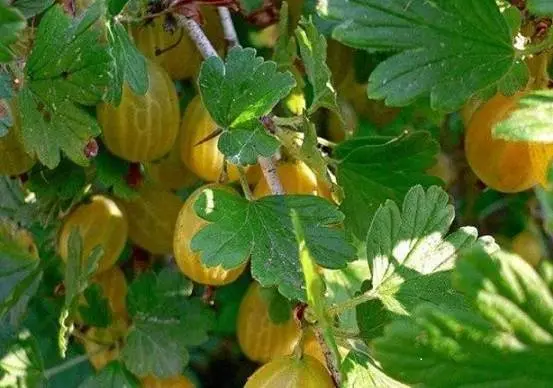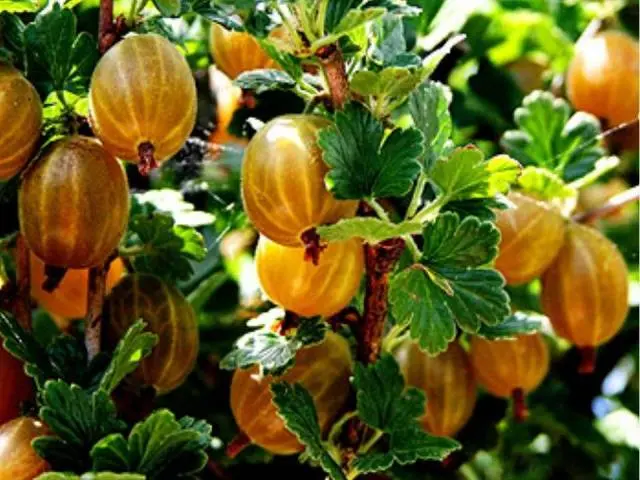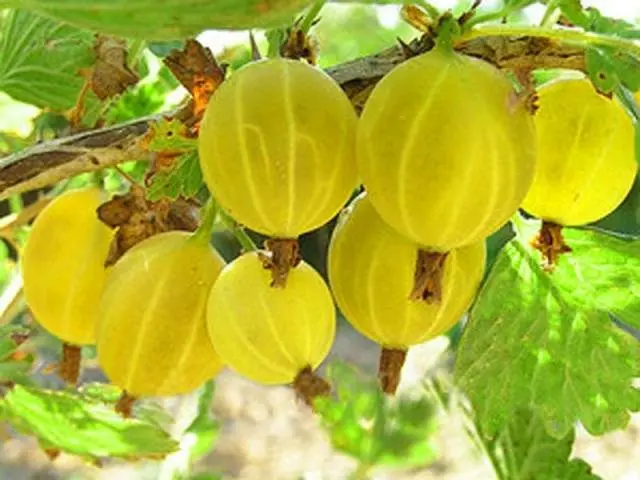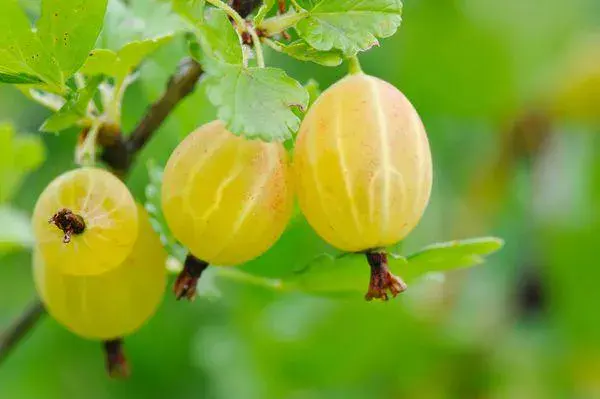Contents
Look at the gooseberry bushes of the Amber variety, it was not for nothing that they called it that, the berries hang on the branches like clusters of amber, shimmer in the sun, are proud of ourselves – we are also little suns, and we also look like pebbles that people find on the sea beach sand.

History of breeding varieties
The gooseberry variety Yantarny was bred by a group of breeders under the leadership of M. Pavlova in the mid-50s, but for reasons unknown to us did not pass registration in the State Register. However, despite all the historical upheavals, the variety was preserved and many nurseries still successfully grow this gooseberry and sell the fruits and seedlings of the Amber gooseberry to the population of Our Country, export them to many countries of the world.
Description of the bush and berries
Gooseberry Amber is a tall shrub reaching one and a half meters in height, its branches are thick and sprawling, requiring garters on supports or trellises.

Gooseberries are amber (orange-yellow) in color, oval in shape, slightly thickened at one end, the largest and juiciest are distinguished by an excellent sweetish taste with a lobule of acid and honey aroma, their average weight is 5,0 g.
Advantages and disadvantages
Advantages of the variety | Lack of variety |
|
|

Features
Main characteristics of the variety | Indicators |
Height of a plant | Until 1,5 m |
Average weight of berries | Until 5,5 g |
Terms of maturation | Early and middle school |
Attitude towards diseases | Resistant variety, powdery mildew rarely infects it |
Average harvest per season | 7-8 kg |
Record harvest | 10, 5 kg |
Relation to low temperatures | frost-resistant |
Productivity
The quality and quantity of the harvest of Amber Gooseberries increases when all agricultural growing technologies are implemented: when planting and regular pruning, when choosing a place and caring, with timely taking measures to combat diseases and harmful insects.

Drought and winter hardiness
The gooseberry variety Amber is unpretentious and resistant to periods when there is not enough moisture, the plant tolerates winter frosts well, even with a cold of -40 °, the root system is preserved, only twigs that are not sufficiently covered with snow can freeze slightly. Such branches are removed during spring sanitary pruning.
Disease and pest resistance
Gooseberries of the Yantarny variety have natural immunity to many fungal diseases; over many years of testing, it has shown itself to be the best in terms of resistance to the invasion of harmful insects. According to the observations of gardeners, plants rarely get sick and are not very often attacked by pests such as gooseberry aphids.
Ripening period
The ripening of gooseberries depends on the geographical location of the region in which this variety is grown. The warmer the climate, the earlier the berries of the gooseberry variety Yantarny gain fruit maturity. In the south of Our Country, this may be the beginning of June, and in the west and east – mid-July to the end of August. In the northern regions of the country – from July to September, it depends on favorable or not very weather conditions, because the weather is not always the same from year to year.
Transportability
Agro-industrial firms selling gooseberry fruits of the Yantarny variety harvest berries 7-10 days before they are fully ripe, the gooseberry skin at this time is still quite dense and strong, therefore it does not crack or burst during transportation.
Growing conditions
Gooseberry seedlings are best bought and ordered from nurseries with a well-deserved reputation. The age of seedlings should be no more than 1-2 years old with a good root system, and branches with a sufficient number of viable buds.
Features of landing

Amber gooseberry seedlings can be planted at any time convenient for the gardener: in early spring, in the middle of summer or on the eve of winter. According to many gardeners, planting seedlings in late autumn gives even more chances for a quick survival of the plant and its successful development in the future.
The site for planting should be sunny, well fertilized and not blown by drafts, the soil is preferably slightly acidic, neutral or slightly alkaline, the land is fertile and loose. The best option is to plant gooseberries along the fence or wall of the house that faces south. Keep a distance of 1,5 meters between seedlings, if plantings are in 2 or more rows, then there should be at least 2 meters between rows
Care instructions
Gooseberry seedlings of the Yantarny variety grow very quickly, gaining height and density, so you cannot do without certain measures to care for them.
Support
In the second or third year of life, special supports are built around the seedlings and, as necessary, gooseberry branches are tied to its parts.
Additional fertilizing
In the first three years, the Amber gooseberry does not require additional fertilizer if a sufficient amount of organic matter and mineral fertilizers were planted during planting. In the future, top dressing is carried out during the whole season no more than 3 times, organic fertilizers are applied only in early spring.
Pruning of bushes
Pruning is a necessary and regular process when growing gooseberries. Produce it annually, mainly in the spring or after harvest.
Reproduction
Gooseberries can be propagated in two ways: layering and rooting cuttings of the current year. To obtain a large number of seedlings, the second method is more acceptable.
Preparation for winter
After harvesting, gooseberry bushes are sprayed with Bordeaux mixture. Then the earth around the bushes is dug up, combined with top dressing, and sanitary pruning is carried out. If weather forecasters promise a cold winter and long-lasting frosts, then they use an additional insulation – dense agrospan.
Pest and disease control
Diseases | Evidence | Methods of treatment |
Mealy dew (sphere library) | The appearance of a white coating on all parts of the plant, especially on young shoots and leaves. Reproducing, the spores of the fungus affect the ovaries and berries, the plaque gradually darkens and becomes more dense. | Dousing the bushes with boiling water in the spring (March-April), treatment with special fungicides, the use of folk remedies |
Antraknoz | White smooth spots appear on gooseberry leaves, as they grow, they merge into spots much larger and turn brown | Treatment of bushes with Bordeaux mixture 4-5 times per season every 10-14 days |
septoriosis | The leaves are covered with small grayish spots with a dark border, curl and fall off. | Spray the bushes with a solution of Bordeaux mixture 2-3 times per season |
goblet rust | On the back of the gooseberry leaves, bright orange growths appear in the form of small goblets. | Treated with a solution of Bordeaux liquid 3-4 times during the season |
gooseberry mosaic | Spots of a yellowish tint are located along the leaf veins, the leaf plates dry out, the plant stops growing | This viral disease cannot be cured, the affected bushes are dug up and disposed of, the planting pit is completely disinfected |
Gooseberry pests
vermin | How to fight |
Gooseberry (currant) aphid | During bud break, they are sprayed with fungicides: Fitoverm, Kemifos, Iskra and others |
Listogriz | Preventive treatment with fungicides at bud break |
sawyers | Manual collection of caterpillars, spraying bushes 2-3 times with the same preparations |
Leaflet | Apply identical products before bud swelling and after flowering. |
Ognyevka | Use the same pesticides, spray before and after flowering |
Fallenica | Apply fungicides and folk remedies |

Conclusion
Gooseberry Amber has excellent immunity against many of the listed diseases and pests, and the merit of this is our hardworking breeders. This variety has been gaining popularity among gardeners and farmers of agricultural enterprises for more than 50 years. We hope that many of you will like it too.










